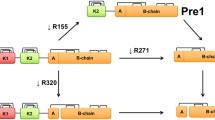Abstract
The interactions of theω-amino acid ligandsε-aminocaproic acid andp-benzylaminesulphonic acid with the isolated kringle 4 domain from human plasminogen have been investigated by1H-nuclear magnetic resonance spectroscopy at 300 and 600 MHz. Overall, the data indicate that binding either ligand does not cause the kringle to undergo significant conformational changes. When p-benzylaminesulphonic acid is in excess relative to the kringles, progressive exchange-broadening and high field chemical shifts are observed for the proton resonances of the ligand. The largest effect is seen at the amino end of the molecule, which indicates that the — NH +3 group of the ligand penetrates deeper into the binding site than does the — SO -3 . Ligand-binding causes signals from the ring-current shifted Leu46 CH δ3 .δ groups and from a number of aromatic side-chains to shift. Depending on the ligand, the latter include Tyr-II (Tyr50), Tyr-V (an immobile ring), His-II and His-III imidazole groups and the three Trp indole groups present in kringle 4. In particular,p-benzylaminesulphonic acid-binding induces large high field shifts on the Trp-II H6 triplet and the Trp-III (Trp72) H2 singlet. On the other hand,ε-aminocaproic acid bound to kringle 4 exhibits large chemical shifts of its CH2 proton resonances, which indicates that the lysine-binding site is rich in aromatic side chains.
Overhauser experiments centered on thep-benzylaminesulphonic acid H2,6 and H3,5 aromatic transitions as well as on the shifted Trp-II and Trp-III signals reveal efficient cross-relaxation between these two indole side chains and thep-benzylaminesulphonic acid ring. These experiments also show that the side chains from Phe64, Tyr-II (Tyr50), Tyr-IV, and His-II (His31) interact with the ligand. In combination with reported chemical modification experiments that show requirement of Asp57, Arg71 and Trp72 integrity for ligand-binding, our study underscores the relevance of the Cys51-Cys75 loop in defining the kringles’ lysine-binding site. Furthermore, the Cys22-Cys63 loop is folded so as to place His31, His33, Tyr41 and Leu46 in proximity to the binding site. The involvement of residues within the Cys51-Cys75 loop in ligand-binding suggests that Trp-II and Tyr-IV may correspond to Trp62 and Tyr74, respectively. As shown by Overhauser experiments, these two residues are in close contact with each other. From these studies and from the shielding and deshielding effects caused byp-benzylaminesulphonic acid, we suggest that the ligand is sandwiched between the indole rings of Trp-II and Trp-III, which form part of the hydrophobic binding site.
Similar content being viewed by others
Abbreviations
- BASA:
-
p-benzylaminesulphonic acid
- K4:
-
kringle 4
- NOE:
-
nuclear Overhauser effect
- ppm:
-
parts-per-million
- pH* :
-
glass electrode pH reading unconnected for deuterium isotope effects
- rf:
-
radio frequency
- TSP:
-
sodium 3-trimethylsilyl(2,2,3,3-2H4) propionate
References
Bothner-by, A. A. (1979) inBiological Applications of Magnetic Resonance, (ed. R. G. Shulman) (New York; Academic Press) p. 177.
Bovey, F. A. (1969)Nuclear Magnetic Resonance Spectroscopy, (New York: Academic Press) p. 264.
De Marco, A. (1977)J. Magn. Reson.,26, 527.
De Marco, A., Hochschwender, S. M., Laursen, R. A., and Llinás, M. (1982)J. Biol. Chem.,257, 12716.
De Marco, A., Laursen, R. A., and Llinás, M. (1985a)Biochim. Biophys. Acta,827, 369.
De Marco, A., Pluck, N. D., Bányai, L., Trexler, M., Laursen, R. A., Patthy, L., Llinás, M. and Williams, R. J. P. (1985b)Biochemistry,24, 748.
De Marco, A., Motta, A., Laursen, R. A. and Llinás, M. (1985c)Biophys. J., (in press).
Ernst, R. E. (1966)Adv. Magn. Reson.,2, 1.
Ferrige, A. G. and Lindon, J. C. (1978)J. Magn. Reson.,31, 337.
Hochschwender, S. M. and Laursen, R. A. (1981)J. Biol. Chem.,256, 11172.
Hochschwender, S. M., Laursen, R. A., De Marco, A., Llinás, M. (1983)Arch. Biochem. Biophys.,223, 58.
Lerch, P. G. and Rickli, E. E. (1980)Biochim. Biophys. Acta. 625, 374.
Lerch, P. G., Rickli, E. E., Lergier, W. and Gillessen, D. (1980)Eur. J. Biochem.,107, 7.
Llinás, M., De Marco, A., Hochschwender, S. M. and Laursen, R. A. (1983)Eur. J. Biochem.,135, 379.
Mark wardt, F. (1978) in Fibrinolytics and Antifibrinolytics (ed. F. Markward,) (Berlin: Springer-Verlag) p. 511.
Okamoto, S., Oshiba, S., Mihara, H. and Okamoto, U. (1968)Ann. N. Y. Acad. Sci.,146, 414.
Patthy, L., Trexler, M., Váli, Z., Bányai, L. and Varadi, A. (1984)FEBS Lett.,171, 131.
Perkins, S. J. (1982)Biol. Magn. Resonance,4, 193.
Sottrup-Jensen, L., Claeys, H., Zajdel, M., Petersen, T. E. and Magnusson, S. (1978)Progr. Chem. Fibrinolysis Trombolysis,3, 191.
Trexler, M., Váli, Z. and Patthy, L. (1982)J. Biol. Chem.,257, 7401.
Trexler, M., Bányai, L., Patthy, L., Pluck, N. D. and Williams, R. J. P. (1983)FEBS Lett.,154, 311.
Trexler, M. and Patthy, L. (1983)Proc. Natl. Acad. Sci. USA,80, 2457.
Trexler, M. and Patthy, L. (1984)Biochim. Biophys. Acta,787, 275.
Winn, E. S., Hu, S. P., Hochschwender, S. M. and Laursen, R. A. (1980)Eur. J. Biochem.,104, 579.
Author information
Authors and Affiliations
Rights and permissions
About this article
Cite this article
Llinás, M., Motta, A., De Marco, A. et al. Kringle 4 from human plasminogen:1H-nuclear magnetic resonance study of the interactions between ω-amino acid ligands and aromatic residues at the lysine-binding site. J. Biosci. 8, 121–139 (1985). https://doi.org/10.1007/BF02703971
Published:
Issue Date:
DOI: https://doi.org/10.1007/BF02703971




